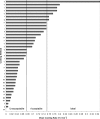Acute whole-body cooling for exercise-induced hyperthermia: a systematic review
- PMID: 19180223
- PMCID: PMC2629045
- DOI: 10.4085/1062-6050-44.1.84
Acute whole-body cooling for exercise-induced hyperthermia: a systematic review
Abstract
Objective: To assess existing original research addressing the efficiency of whole-body cooling modalities in the treatment of exertional hyperthermia.
Data sources: During April 2007, we searched MEDLINE, EMBASE, Scopus, SportDiscus, CINAHL, and Cochrane Reviews databases as well as ProQuest for theses and dissertations to identify research studies evaluating whole-body cooling treatments without limits. Key words were cooling, cryotherapy, water immersion, cold-water immersion, ice-water immersion, icing, fanning, bath, baths, cooling modality, heat illness, heat illnesses, exertional heatstroke, exertional heat stroke, heat exhaustion, hyperthermia, hyperthermic, hyperpyrexia, exercise, exertion, running, football, military, runners, marathoner, physical activity, marathoning, soccer, and tennis.
Data synthesis: Two independent reviewers graded each study on the Physiotherapy Evidence Database (PEDro) scale. Seven of 89 research articles met all inclusion criteria and a minimum score of 4 out of 10 on the PEDro scale.
Conclusions: After an extensive and critical review of the available research on whole-body cooling for the treatment of exertional hyperthermia, we concluded that ice-water immersion provides the most efficient cooling. Further research comparing whole-body cooling modalities is needed to identify other acceptable means. When ice-water immersion is not possible, continual dousing with water combined with fanning the patient is an alternative method until more advanced cooling means can be used. Until future investigators identify other acceptable whole-body cooling modalities for exercise-induced hyperthermia, ice-water immersion and cold-water immersion are the methods proven to have the fastest cooling rates.
Keywords: cryotherapy; evidence-based practice; exertional heat illness; modalities.
Figures


References
-
- McDermott B.P, Casa D.J, Ganio M.S, Yeargin S.W, Armstrong L.E, Maresh C.M. Recovery and return to activity following exertional heat stroke: considerations for the sports medicine staff. J Sport Rehabil. 2007;16(3):163–181. - PubMed
-
- Armstrong L.E, Casa D.J, Millard-Stafford D, Moran D, Pyne S.W, Roberts W.O. American College of Sports Medicine position stand: exertional heat illnesses during training and competition. Med Sci Sports Exerc. 2007;39(3):556–572. - PubMed
-
- Casa D.J, Almquist J, Anderson S, et al. Inter-Association Task Force on Exertional Heat Illnesses consensus statement. NATA News. Jun, 2003. pp. 24–29.
-
- Casa D.J, Armstrong L.E, Ganio M.S, Yeargin S.W. Exertional heat stroke in competitive athletes. Curr Sports Med Rep. 2005;4(6):309–317. - PubMed
Publication types
MeSH terms
Grants and funding
LinkOut - more resources
Full Text Sources
Medical
Miscellaneous

